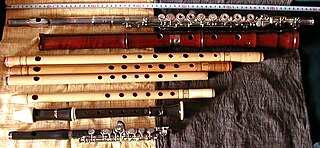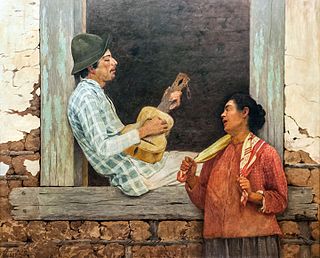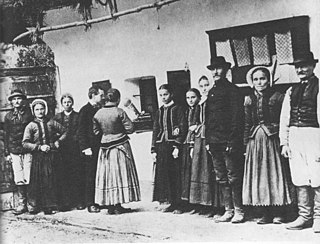
Folk music includes traditional folk music and the genre that evolved from it during the 20th-century folk revival. Some types of folk music may be called world music. Traditional folk music has been defined in several ways: as music transmitted orally, music with unknown composers, or music performed by custom over a long period of time. It has been contrasted with commercial and classical styles. The term originated in the 19th century, but folk music extends beyond that.

The dombyra is a long-necked Kazakh lute and a musical string instrument. The dombyra shares certain characteristics with the komuz and dutar. It is a popular instrument among Turkic communities in Central Asian countries such as Kazakhstan, Uzbekistan, Turkmenistan, Afghanistan, as well as Mongolia.

The gudok, gudochek, or hudok is an ancient Eastern Slavic string musical instrument, played with a bow.
Persian traditional music or Iranian traditional music, also known as Persian classical music or Iranian classical music, refers to the classical music of Iran. It consists of characteristics developed through the country's classical, medieval, and contemporary eras.

Belarus is an Eastern European country with a rich tradition of folk and religious music. The country's folk music traditions can be traced back to the times of the Grand Duchy of Lithuania. In the 20th century, the Soviet control of the country somewhat limited musical development because nationally oriented music was considered subversive and dangerous to the Soviet authority. The country's musical traditions spread with its people to countries like Russia, Canada, United States, Kazakhstan, Latvia and Ukraine. The people of Belarus were exposed mostly to Russian pop music during this period and also after independence in 1991. In 2002, however, Alexander Lukashenko has signed a decree requiring 50% of all FM broadcast music to be Belarusian in origin, and since January 1, 2005 the rule was made even stricter. However, it does not regulate the language of the songs, so most of the music which is broadcast is still in Russian.

The kaval is a chromatic end-blown flute traditionally played throughout Armenia, the Balkans and Turkey. The kaval is primarily associated with mountain shepherds.

The zurna, is a wind instrument played in central Eurasia, western Asia and parts of North Africa. It is usually accompanied by a davul in Anatolian and Assyrian folk music.
In music, a drone is a harmonic or monophonic effect or accompaniment where a note or chord is continuously sounded throughout most or all of a piece. The word drone is also any part of a musical instrument that is used to produce such an effect, as is the archaic term burden such as a "drone [pipe] of a bagpipe", the pedal point in an organ, or the lowest course of a lute. Α burden is also part of a song that is repeated at the end of each stanza, such as the chorus or refrain.
Various kinds of Arab music are popular in Libya such as Andalusi music, locally known as Ma'luf, Chabi and Arab classical music.
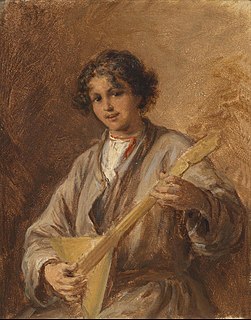
Russian traditional music specifically deals with the folk music traditions of the ethnic Russian people. It does not include the various forms of art music, which in Russia often contains folk melodies and folk elements or music of other ethnic groups living in Russia.
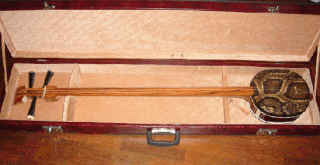
The sanxian is a Chinese lute—a three-stringed fretless plucked musical instrument. It has a long fingerboard, and the body is traditionally made from snake skin stretched over a rounded rectangular resonator. It is made in several sizes for different purposes and in the late 20th century a four-stringed version was also developed. The northern sanxian is generally larger, at about 122 cm (48 in) in length, while southern versions of the instrument are usually about 95 cm (37 in) in length.

Samul nori (사물놀이) is a genre of percussion music that originated in Korea. The word samul means "four objects", while nori means "play". Samul nori is performed with four traditional Korean musical instruments called pungmul. These are Kkwaenggwari (꽹과리), a small gong; Jing (징), a larger gong; Janggu (장구), an hourglass-shaped drum; and Buk (북), a barrel drum similar to the bass drum.
The twi ba is a percussive musical instrument, popular within the Caribbean. It is usually used in the folk music of Guadeloupe. The twi ba is a type of idiophone, which is an instrument that makes sound based on the vibrations caused by making contact with the instrument.
Komal Kothari was an Indian folk artist and classical singer.

Krosswindz is a Bengali rock/folk-fusion band, based in Kolkata, India. They have played all over India and abroad, and have helped urbanize the folk music of Bengal and have tried to make it popular. Krosswindz is one of the few Kolkata based Bengali rock bands who have female singers in their lead vocals.

Classical music is art music produced or rooted in the traditions of Western culture, including both liturgical (religious) and secular music. While a more precise term is also used to refer to the period from 1750 to 1820, this article is about the broad span of time from before the 6th century AD to the present day, which includes the Classical period and various other periods. The central norms of this tradition became codified between 1550 and 1900, which is known as the common-practice period. The major time divisions of Western art music are as follows:

Indira Kala Sangeet Vishwavidyalaya (IKSV), also Indira Kala Sangeet University, is a public university located in Khairagarh, Rajnandgaon district, Chhattisgarh, India.

Vasily Vasilievich Andreyev was a Russian musician responsible for the modern development of the balalaika and several other traditional Russian folk music instruments, and is considered the father of the academic folk instrument movement in Eastern Europe. His accomplishments included:

The scale of harmonics is a musical scale based on the noded positions of the natural harmonics existing on a string. This musical scale is present on the guqin, regarded as one of the first string instruments with a musical scale. Most fret positions appearing on Non-Western string instruments (lutes) are equal to positions of this scale. Unexpectedly, these fret positions are actually the corresponding undertones of the overtones from the harmonic series. The distance from the nut to the fret is an integer number lower than the distance from the fret to the bridge.

The Indian santoor instrument is a trapezoid-shaped hammered dulcimer, and a variation of the Iranian Santur. The instrument is generally made of walnut and has 25 bridges. Each bridge has 4 strings, making for a total of 100 strings. It is a traditional instrument in Jammu and Kashmir, and dates back to ancient times. It was called Shatha Tantri Veena in ancient Sanskrit texts.
